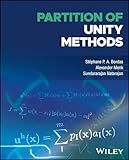Partition of unity methods / Stephane P.A. Bordas, Alexander Menk, Sundararajan Natarajan.
By: Bordas, Stephane P.A [author.]
Contributor(s): Menk, Alexander [author.] | Natarajan, Sundararajan [author.]
Language: English Publisher: Hoboken, NJ : John Wiley & Sons, Inc., 2024Copyright date: ©2024Description: 1 online resourceContent type: text Media type: computer Carrier type: online resourceISBN: 9780470667088 ; 9781118535875; 1118535871; 9781118535899; 1118535898Subject(s): Finite element methodGenre/Form: Electronic books.DDC classification: 620.001/51535 LOC classification: TA347.F5 | B67 2024Online resources: Full text available at Wiley Online Library Click here to view.| Item type | Current location | Home library | Call number | Status | Date due | Barcode | Item holds |
|---|---|---|---|---|---|---|---|
 EBOOK
EBOOK
|
COLLEGE LIBRARY | COLLEGE LIBRARY | 620.00151535 B64472 2024 (Browse shelf) | Available |
Table of Contents
List of Contributors xi
Preface xiii
Acknowledgments xv
1 Introduction 1
1.1 The Finite Element Method 2
1.2 Suitability of the Finite Element Method 9
1.3 Some Limitations of the FEM 11
1.4 The Idea of Enrichment 16
1.5 Conclusions 19
2 A Step-by-Step Introduction to Enrichment 23
2.1 History of Enrichment for Singularities and Localized Gradients 25
2.2 Weak Discontinuities for One-dimensional Problems 38
2.3 Strong Discontinuities for One-dimensional Problem 58
2.4 Conclusions 61
3 Partition of Unity Revisited 67
3.1 Completeness, Consistency, and Reproducing Conditions 67
3.2 Partition of Unity 68
3.3 Enrichment 69
3.4 Numerical Examples 86
3.5 Conclusions 95
4 Advanced Topics 99
4.1 Size of the Enrichment Zone 99
4.2 Numerical Integration 100
4.3 Blending Elements and Corrections 108
4.4 Preconditioning Techniques 116
5 Applications 125
5.1 Linear Elastic Fracture in Two Dimensions with XFEM 125
5.2 Numerical Enrichment for Anisotropic Linear Elastic Fracture Mechanics 130
5.3 Creep and Crack Growth in Polycrystals 133
5.4 Fatigue Crack Growth Simulations 138
5.5 Rectangular Plate with an Inclined Crack Subjected to Thermo-Mechanical Loading 140
6 Recovery-Based Error Estimation and Bounding in XFEM 145
6.1 Introduction 145
6.2 Error Estimation in the Energy Norm. The ZZ Error Estimator 147
6.3 Recovery-based Error Estimation in XFEM 151
6.4 Recovery Techniques in Error Bounding. Practical Error Bounds. 174
6.5 Error Estimation in Quantities of Interest 179
7 Φ-FEM: An Efficient Simulation Tool Using Simple Meshes for Problems in Structure Mechanics and Heat Transfer 191
7.1 Introduction 191
7.2 Linear Elasticity 194
7.3 Linear Elasticity with Multiple Materials 204
7.4 Linear Elasticity with Cracks 208
7.5 Heat Equation 212
7.6 Conclusions and Perspectives 214
8 eXtended Boundary Element Method (XBEM) for Fracture Mechanics and Wave Problems 217
8.1 Introduction 217
8.2 Conventional BEM Formulation 218
8.3 Shortcomings of the Conventional Formulations 226
8.4 Partition of Unity BEM Formulation 228
8.5 XBEM for Accurate Fracture Analysis 228
8.6 XBEM for ShortWave Simulation 235
8.7 Conditioning and its Control 243
8.8 Conclusions 245
9 Combined Extended Finite Element and Level Set Method (XFE-LSM) for Free Boundary Problems 249
9.1 Motivation 249
9.2 The Level Set Method 250
9.3 Biofilm Evolution 256
9.4 Conclusion 269
10 XFEM for 3D Fracture Simulation 273
10.1 Introduction 273
10.2 Governing Equations 274
10.3 XFEM Enrichment Approximation 275
10.4 Vector Level Set 280
10.5 Computation of Stress Intensity Factor 282
10.6 Numerical Simulations 288
10.7 Summary 300
11 XFEM Modeling of Cracked Elastic-Plastic Solids 303
11.1 Introduction 303
11.2 Conventional von Mises Plasticity 303
11.3 Strain Gradient Plasticity 312
11.4 Conclusions 323
12 An Introduction to Multiscale analysis with XFEM 329
12.1 Introduction 329
12.2 Molecular Statics 330
12.3 Hierarchical Multiscale Models of Elastic Behavior -- The Cauchy-Born Rule 336
12.4 Current Multiscale Analysis -- The Bridging Domain Method 338
12.5 The eXtended Bridging Domain Method 340
References 344
Index 345
While it is the number one tool for computer aided design and engineering, the finite element method (FEM) has difficulties with discontinuities, singularities, and moving boundaries. Partition of unity methods addresses these challenges and is now increasingly implemented in commercially available software. Partition of Unity Methods delivers a detailed overview of its fundamentals, in particular the extended finite element method for applications in solving moving boundary problems. The distinguished academics and authors introduce the XFEM as a natural extension of the traditional finite element method (FEM), through straightforward one-dimensional examples which form the basis for the subsequent introduction of higher dimensional problems. This book allows readers to fully understand and utilize XFEM just as it becomes ever more crucial to industry practice.
About the Author
Stéphane P. A. Bordas is a Professor in Computational Mechanics and earned his PhD from Northwestern University, USA, in 2004. He has published over 200 papers in unfitted simulation of free boundary problems and data driven modelling of complex systems. He has supervised over 30 PhD students and is Editor- in-Chief of Advances in Applied Mechanics.
Alexander Menk is employed by Bosch GmbH. He is a PhD graduate from Glasgow University, UK, supervised by Prof. Bordas. His contributions range from automatic numerically determined enrichment to preconditioners for extended finite element methods for fracture.
Sundararajan Natarajan has been a Professor of Computational Mechanics since 2014 and earned his PhD from Cardiff University, UK, supervised by Prof. Bordas and Prof. Kerfriden. He has made strong contributions to a number of methods on unfitted methods for free boundary problems, in particular on numerical integration and strain smoothing.

There are no comments for this item.